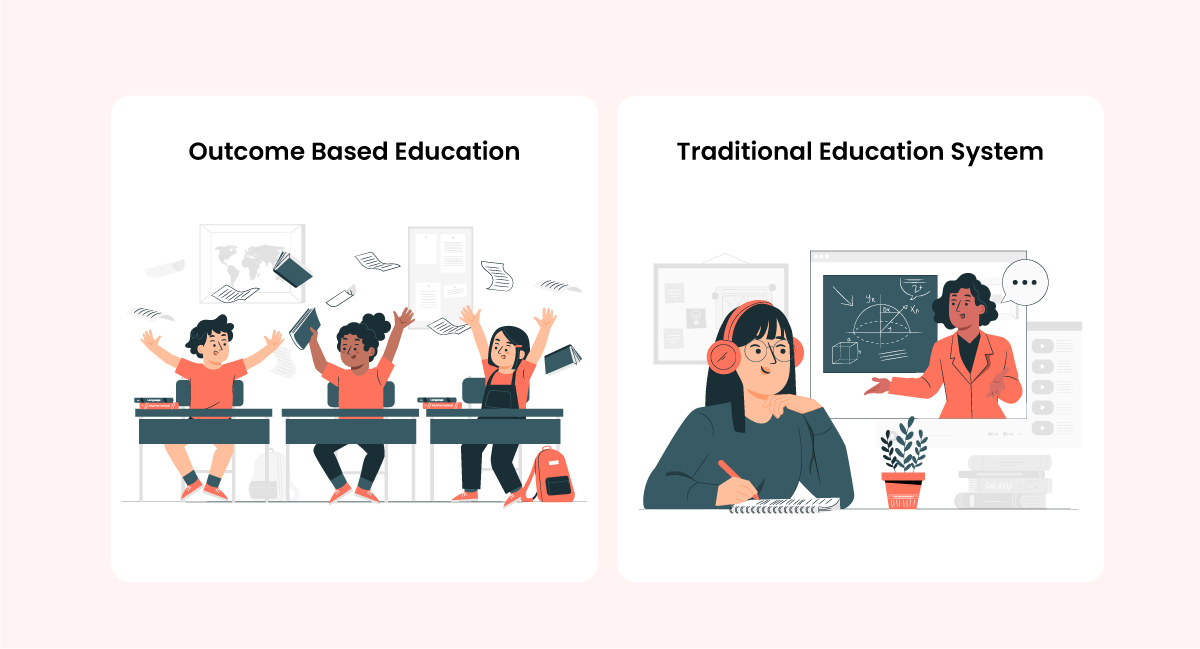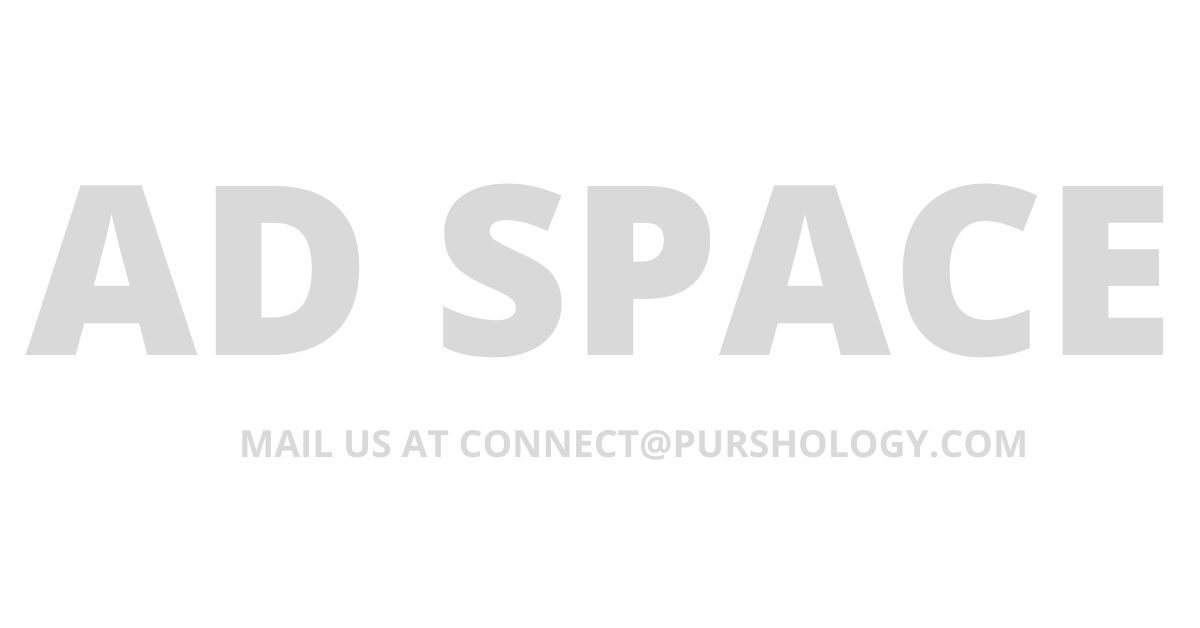Outcome-Based Education (OBE) and the traditional education system are two distinct approaches to learning and assessment, each with its own unique principles and specific teaching methodologies. Although both systems share the goal of providing students with knowledge and skills, they differ significantly in their core philosophies.
Traditional education, often referred to as content-based education, focuses on delivering subject matter and the acquisition of knowledge. Students and teachers typically follow a predetermined curriculum that includes lectures, textbooks, and exams.
The primary emphasis is on content coverage and evaluating student performance through standardized tests and grades. The main objective of teachers is to transmit knowledge and assess students based on their ability to recall and reproduce information.
In contrast, outcome based learning shifts the focus from content delivery to student outcomes. OBE is a learner-centered approach that places great importance on defining desired learning outcomes and designing instructional strategies to achieve those outcomes.
In OBE, assessment methods are aligned with the desired outcomes, and students are evaluated based on their demonstrated mastery of the expected skills and competencies. This approach fosters a deeper understanding of the subject matter and encourages students to take ownership of their learning process.
Expert Advice
The outcomes-based model emphasizes measurable outcomes and practical application while also encouraging critical thinking and adaptability. The traditional system, on the other hand, emphasizes knowledge acquisition and standardized assessments, often overlooking individual strengths and stifling creativity.
What Is Outcome Based Education System (OBE)?
Outcome-based education is an educational system that prioritizes the desired learning outcomes over the content or processes of education. It is a thought process that starts with establishing particular, measurable, and observable abilities along with new skills, knowledge gained, and attitudes that students should develop. These outcomes then serve as the foundation for instructional design, assessment, and evaluation.
OBE shifts the focus from teacher-centered and focused instruction to learner-centered and focused approaches, focused on fostering critical thinking, problem-solving, and practical skills relevant to real-world contexts. Students actively participate in learning through aligned activities, projects, and assessments.

Educators adopting OBE use a systematic approach, aligning instructional strategies, written assessments, courses, assessment methods, and feedback mechanisms with the desired outcomes. OBE encourages a holistic understanding of three components of student achievement.
Ultimately, the goal of OBE is to have leading institutions produce the next generation of competent, capable graduates ready for the professional world by aligning higher education itself with society’s expectations and desired outcomes.
What is the Traditional Education System?
The traditional education system refers to the long-standing conventional approach to education. It typically follows a teacher-centered model, where the teacher is the primary source of knowledge, and students passively receive information. The curriculum in this system is usually predetermined, focusing on specific subjects and content.

The primary teaching techniques in traditional education mainly rely on lectures, textbooks, and memorization. Tests and examinations are the main types of assessments since they measure how well pupils can remember and replicate material. There are few possibilities for student cooperation or active involvement in classroom interactions, which frequently center on teacher-student exchanges.
The traditional education system places a strong emphasis on academic achievement and grades, with success commonly measured by performance in standardized tests. The primary focus is on acquiring knowledge, and meeting predetermined academic standards rather than developing critical thinking, problem-solving, and practical skills.
However, there is a growing recognition of the need for more learner-centered and experiential learning approaches to better equip students for the challenges of the learning experience of the modern world.
What Is the Difference Between Outcome-Based Education and the Traditional Education System?
In order to shape people and societies, education software is essential. Different educational philosophies have developed throughout history, each with its own unique traits.

Outcome-based education vs. traditional education are the two prominent models that contrast one another. The main difference between outcome based education and traditional education are listed below. Let’s look at them now!
1. Outlining & Designing The Curriculum
The traditional education system adheres to a content-driven curriculum that emphasizes knowledge transmission from teacher to student. It is a curriculum usually consisting of predetermined subjects, topics, and textbooks, with a predetermined learning sequence.
The primary emphasis of traditional curriculum teaching is on covering a broad range of topics, with less emphasis on real-world application or relevance. Outcome-based education, on the other hand, is centered on clearly defined learning outcomes.
The curriculum is created by identifying specific goals, course outcomes, and competencies that students must attain. These outcomes are the result of an examination of the abilities, knowledge, and attitudes required for success in real-world situations. OBE promotes a learner-centered approach that emphasizes knowledge application, critical thinking, problem-solving, and communication skills.
2. Grading System
The traditional education system evaluates students based on how well they perform on assignments, tests, and exams using a percentage or letter grading system. The main emphasis is on knowledge acquisition, which is frequently assessed through fact memorization and regurgitation. This system occasionally encourages competition and impedes the growth of critical abilities beyond rote memorization.
While using a criterion-referenced grading system, outcome-based education assesses students based on their achievement of particular learning outcomes. OBE evaluates each student’s competency and achievement, as opposed to placing them in a competitive order. This method encourages students to put their attention on mastering the necessary skills and fulfilling the predetermined standards rather than focusing on how they compare to their peers.
3. Scalability Of Final Outcomes
The scalability of the final results is one obvious distinction between outcome-based education and the traditional educational system. With progression determined by time-based benchmarks, the traditional education system frequently places emphasis on finishing a predetermined number of years or grades.
This system makes the assumption that every student advances at the same rate, regardless of personal variations in learning preferences, skills, or interests.
As a result, some students may be held back or pushed ahead without fully mastering the required foundational skills. OBE recognizes that learners’ needs and abilities vary, so it offers opportunities for remediation and enrichment, allowing each student to progress at their own pace. This adaptability fosters a more welcoming and supportive learning environment.
Outcome-based education and the traditional education system represent two distinct approaches to education, each with its own strengths and weaknesses. While the traditional education system focuses on content delivery and knowledge accumulation, OBE prioritizes the attainment of specific learning outcomes through a learner-centered approach.
OBE encourages the application of knowledge, critical thinking, problem-solving, and communication skills. Moreover, OBE adopts a criterion-referenced grading system that assesses individual competency rather than encouraging competition among students.
|
Criteria |
Outcome-based Education |
Traditional Educational System |
|---|---|---|
| Outlining & Designing The Curriculum | OBE promotes a learner-centered approach that emphasizes knowledge application, critical thinking, problem-solving, and communication skills. | The traditional education system adheres to a content-driven curriculum that emphasizes knowledge transmission from teacher to student. |
| Grading System | OBE evaluates each student’s competency and achievement, as opposed to placing them in a competitive order. | The traditional education system evaluates students based on how well they perform on assignments, tests, and exams using a percentage or letter grading system. |
| Scalability Of Final Outcomes | OBE recognizes that learners’ needs and abilities vary, so it offers opportunities for remediation and enrichment, allowing each student to progress at their own pace. | With progression determined by time-based benchmarks, the traditional education system frequently places emphasis on finishing a predetermined number of years or grades. |
Which One Is Better, Outcome Based Education or Traditional Education System?
Since you now know what is OBE and traditional education systems are, it’s now time to choose the best one between them. Determining whether one is better requires a thorough examination of their characteristics, goals, and impact on student learning. The decision between the two models depends on a number of factors, each of which has advantages and disadvantages.
Traditional Education System
The traditional education system has been the dominant model for centuries, focusing on delivering a standardized curriculum and assessing students through exams and grades.
In this model, teachers play a central role, transmitting information to students who are expected to absorb and reproduce it. Lectures, textbooks, and memorization are common instructional methods.
Advantages
Interacting with students from all around the world is quite refreshing. It promotes information exchange and encourages students to widen their studies.
- Extracurricular Activities
Participating in extracurricular activities with peers your own age gives you a chance to develop wholly. These endeavors, whether academic or otherwise, foster all-around development. Apart from being exciting, participating in a variety of extracurricular activities pushes students to maximize their learning potential.
Having a subject teacher present in class is advantageous because students can receive immediate assistance with any questions that arise during lessons. It also encourages more interaction between students and teachers, which improves students’ learning abilities.
Outcome-Based Education (OBE)
OBE is a student-centered approach that shifts the focus from the content covered to the outcomes achieved. It aims to produce competent and capable learners by defining desired outcomes and aligning teaching and assessment methods accordingly.
Advantages
- Learner-Centered Approach
By taking into account their needs, interests, and learning preferences, OBE centers the student at the heart of the educational process. It promotes individualized learning experiences, increasing motivation and engagement.

OBE recognizes the importance of nurturing well-rounded individuals. It places emphasis on the development of life skills, such as communication, teamwork, adaptability, and leadership, alongside academic knowledge.
- Application and Skills Development
In order to best prepare students for potential practical issues, OBE places a high priority on the application of knowledge in authentic contexts.
Determining which approach is better depends on the specific goals, context, and learner needs. Traditional education emphasizes content knowledge and academic achievement, while OBE focuses on personalized learning, skills development, and holistic growth.
The traditional approach can provide students with a strong foundation of knowledge, while OBE prepares students for real-world applications to gain knowledge and fosters the development of essential skills. Ultimately, the goal should be to create an inclusive educational environment that meets the diverse needs of learners and prepares them for success in their personal and professional lives.
Challenges of an Outcomes-Based Education Model vs. Traditional Education System
Some of the most common challenges associated with implementing the OBE model and traditional education system are written below. Let’s dig deep!

1. Clear and Measurable Learning Outcomes
Implementing an outcomes-based education model poses a significant challenge: the need for clear and measurable learning outcomes. Unlike the traditional system that simply covers a broad curriculum, this model requires specific, observable, and measurable outcomes.
Designing and aligning these outcomes with the curriculum becomes a complex task, demanding meticulous planning and coordination among educators.
2. Instructional Design and Pedagogy
Rethinking instructional design and pedagogy is necessary to make the transition from the conventional educational system to an outcomes-based paradigm. In the conventional technique, teachers frequently use a direct, teacher-centered approach. An outcomes-based approach, however, promotes student-centered and hands-on learning.
Due to this paradigm shift, educators must modify their technological advancements and offer opportunities for discussion, collaboration, critical thinking, and active learning to more students. To develop and successfully apply these pedagogical innovations, educators may require professional development and training.
3. Assessment Practices
Another significant challenge is related to assessment processes. To assess student achievement, traditional education mainly relies on standardized tests and exams. An outcomes-based strategy, on the other hand, focuses on measuring students’ mastery of certain skills and competencies.
This involves the skill development of new evaluation methods and strategies that give students authentic and meaningful feedback. Furthermore, educators must address questions about the dependability and validity of alternate evaluation systems.
4. Stakeholder Engagement and Support
Shifting to an outcomes-based education model requires garnering strong stakeholder buy-in and support. This includes securing the support of teachers, parents, administrators, and policymakers.
Clear communication and transparency regarding the benefits, goals, and processes of the new model are vital to address concerns and overcome resistance to change. Cultivating a collaborative and supportive environment among stakeholders is pivotal for successful implementation.
Teachers and educational institutions themselves may successfully negotiate the challenging traditional education system by using new skills and addressing these issues head-on. This releases the potential of an outcomes-based education paradigm to foster deeper learning, critical thinking, and real-world skills among students.
Conclusion
While both approaches mentioned in the blogs have prominent advantages, the outcomes-based model appears to be better suited to meet the demands of a rapidly changing world.
Since it cultivates well-rounded individuals capable of thriving in a variety of settings, it is the preferred alternative. Connect with our expert teams and learn more about outcomes-based education and traditional education systems today.
Frequently Asked Questions

Supriya is a highly skilled content writer with over 8 years of experience in the SaaS domain. She believes in curating engaging, informative, and SEO-friendly content to simplify highly technical concepts. With an expansive portfolio of long-format blogs, newsletters, whitepapers, and case studies, Supriya is dedicated to staying in touch with emerging SaaS trends to produce relevant and reliable content.
Need Any Technology Assistance? Call Pursho @ 0731-6725516





